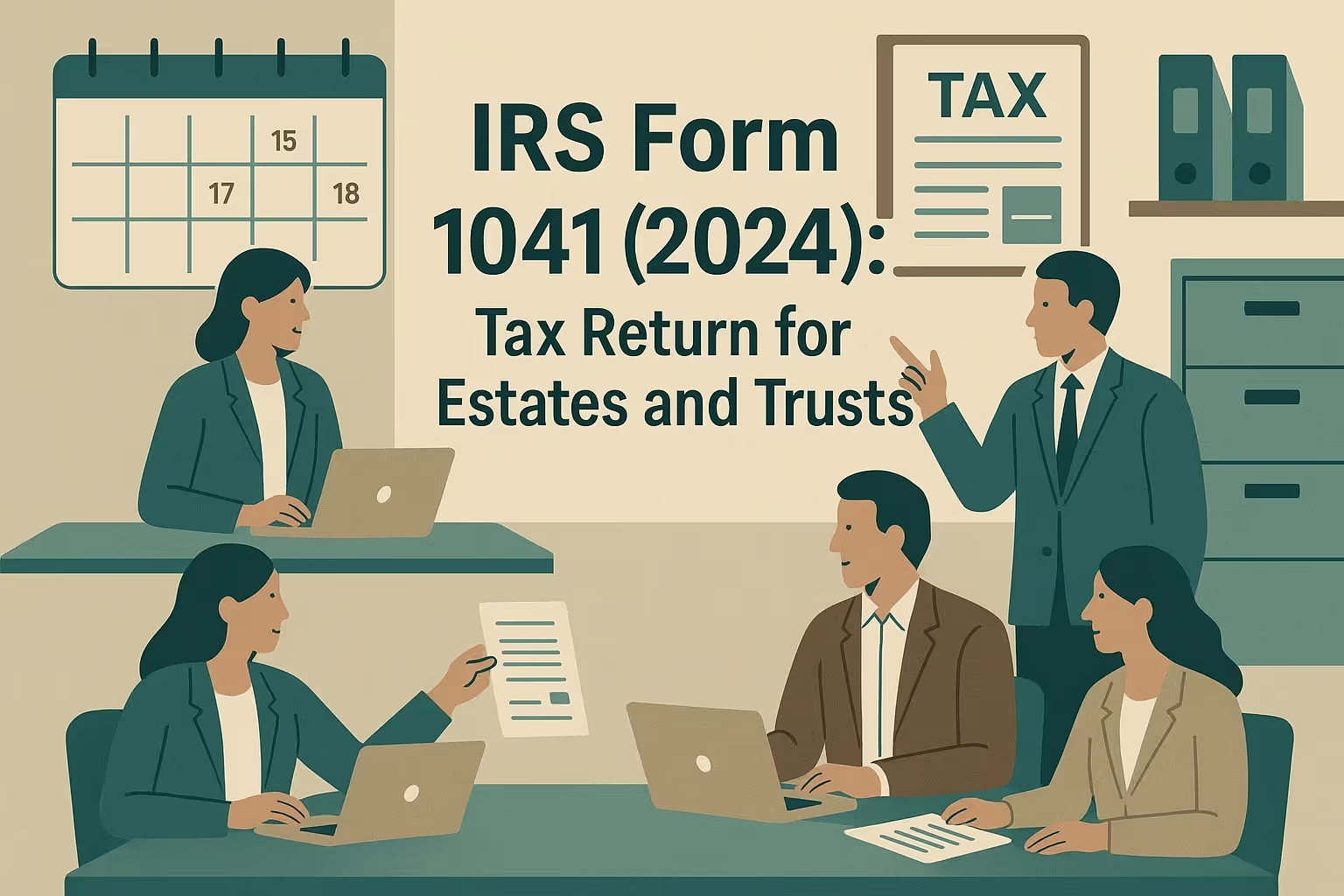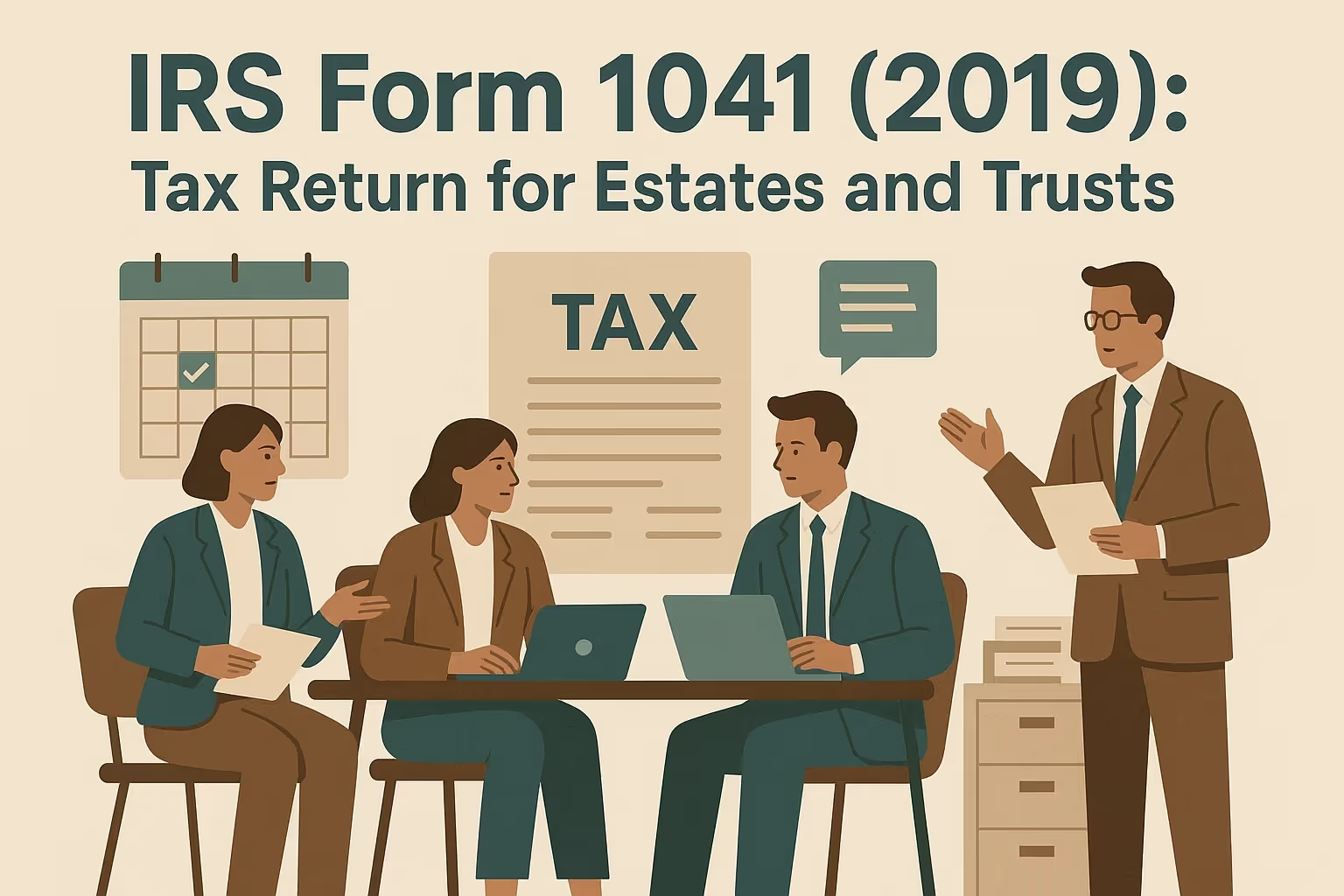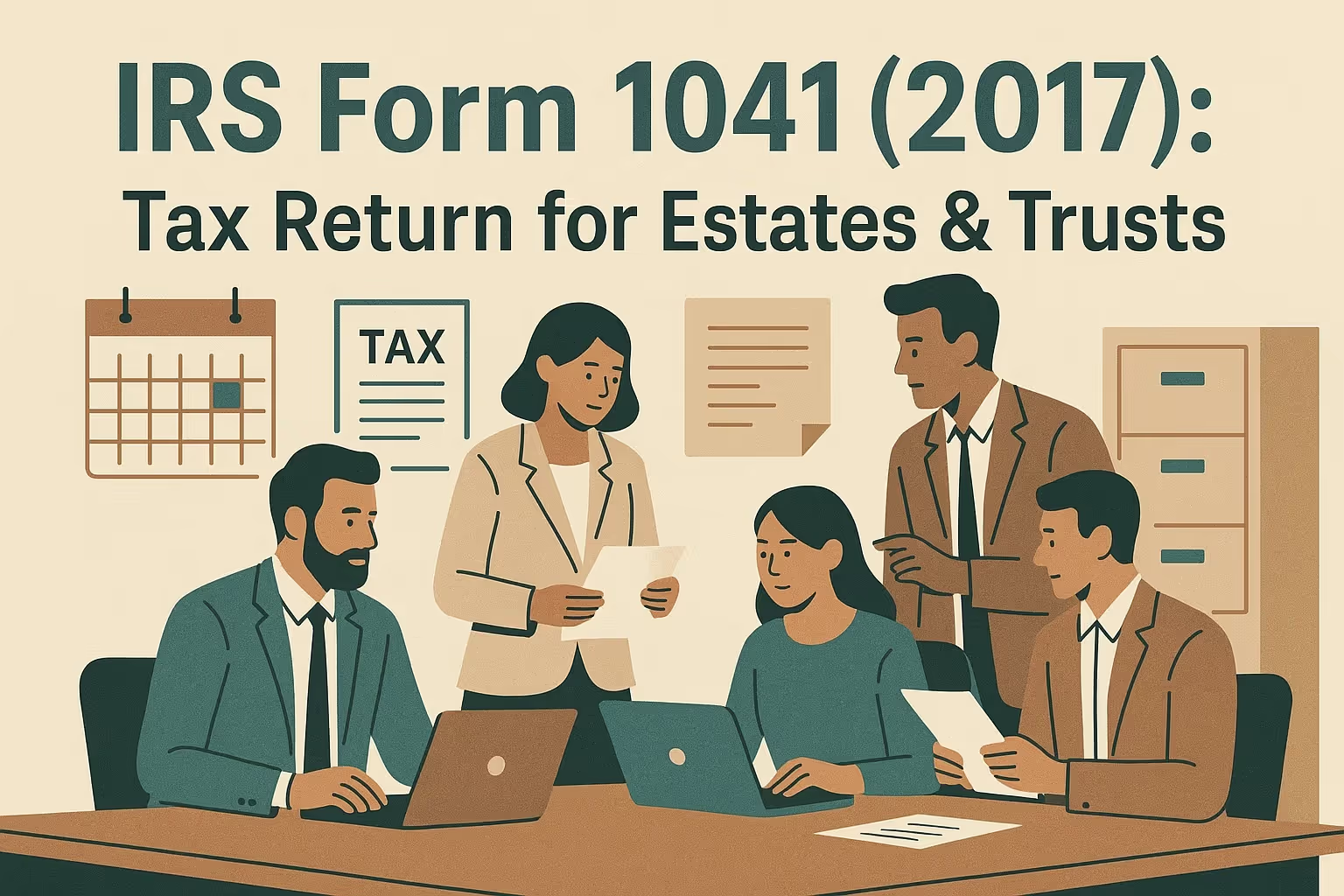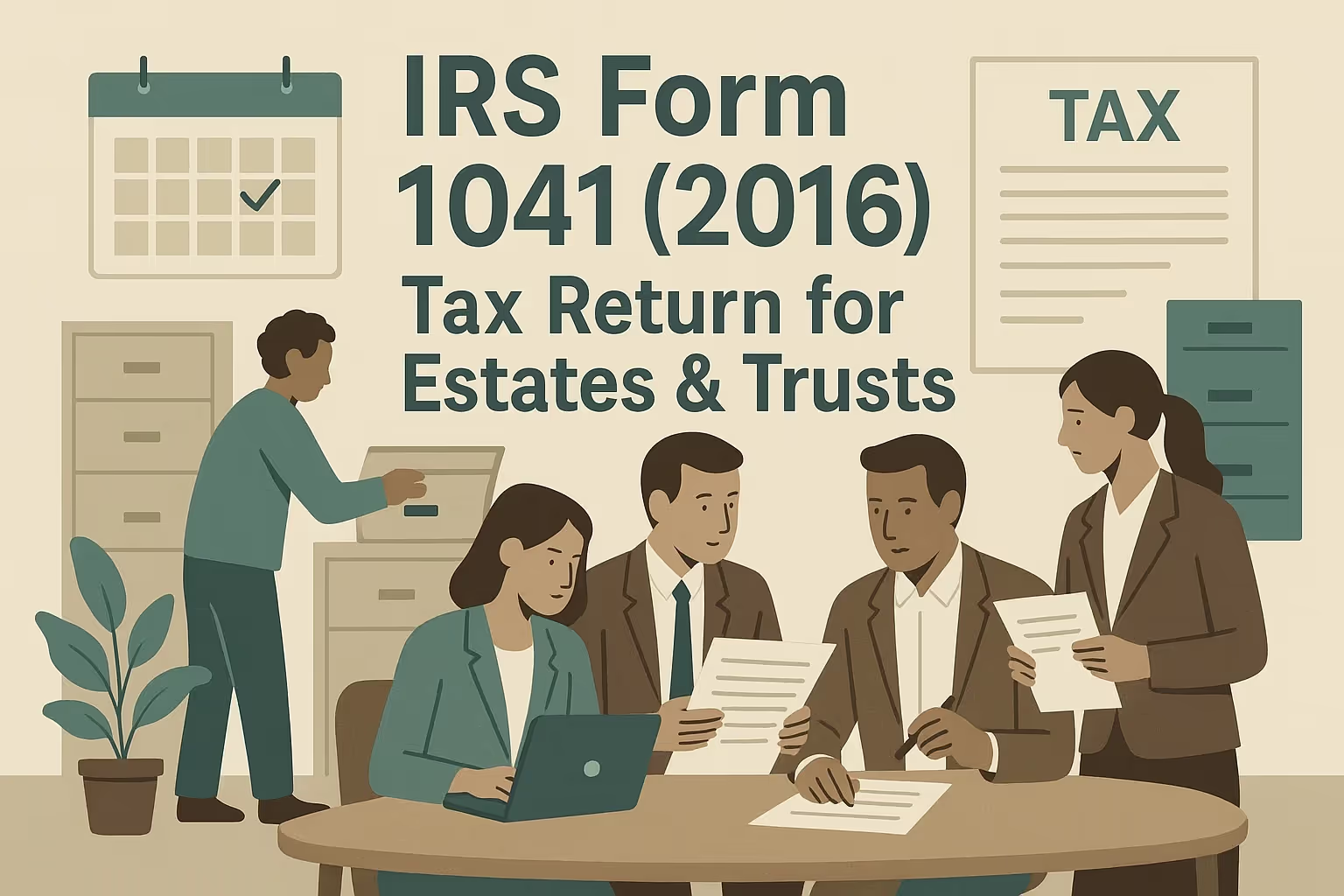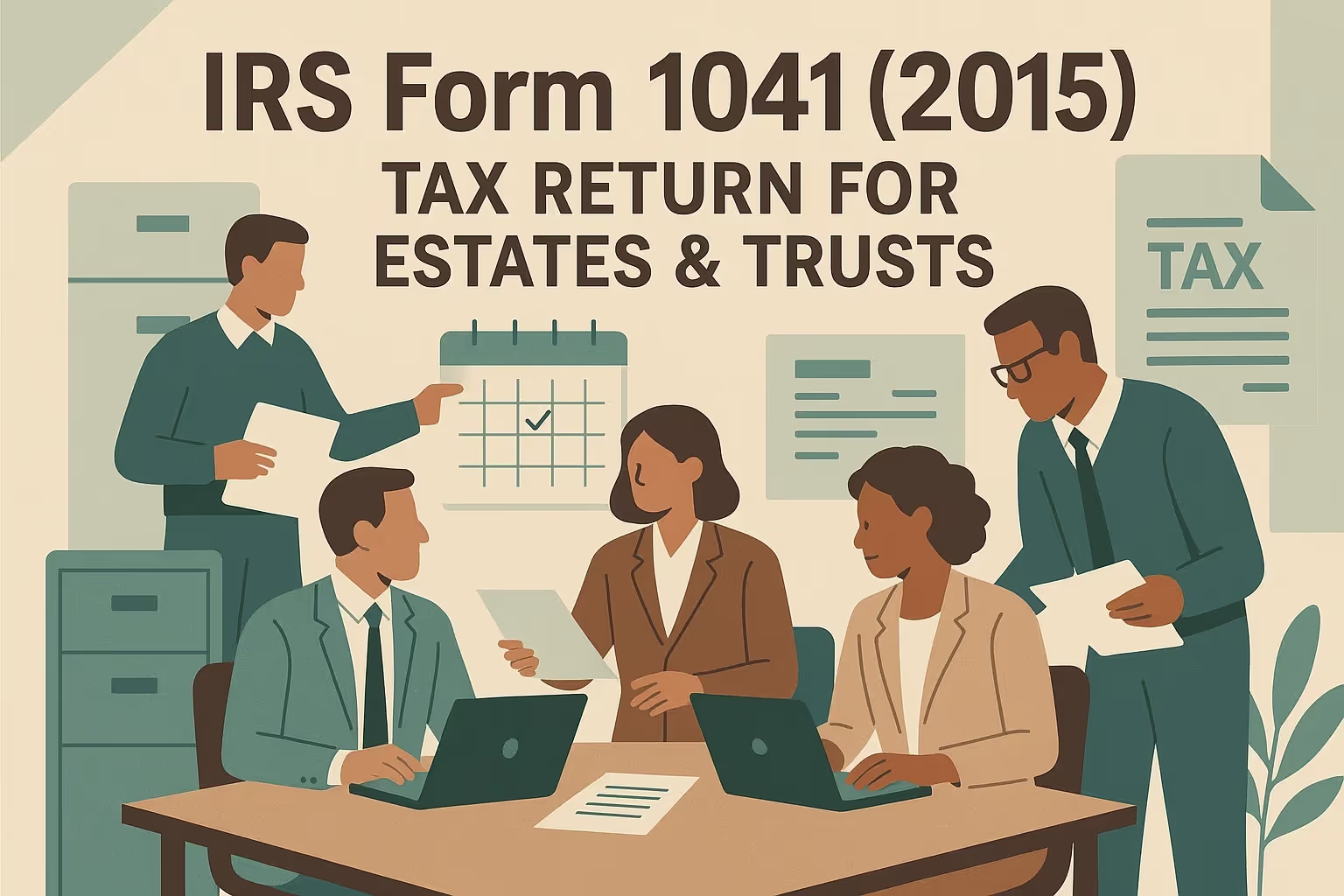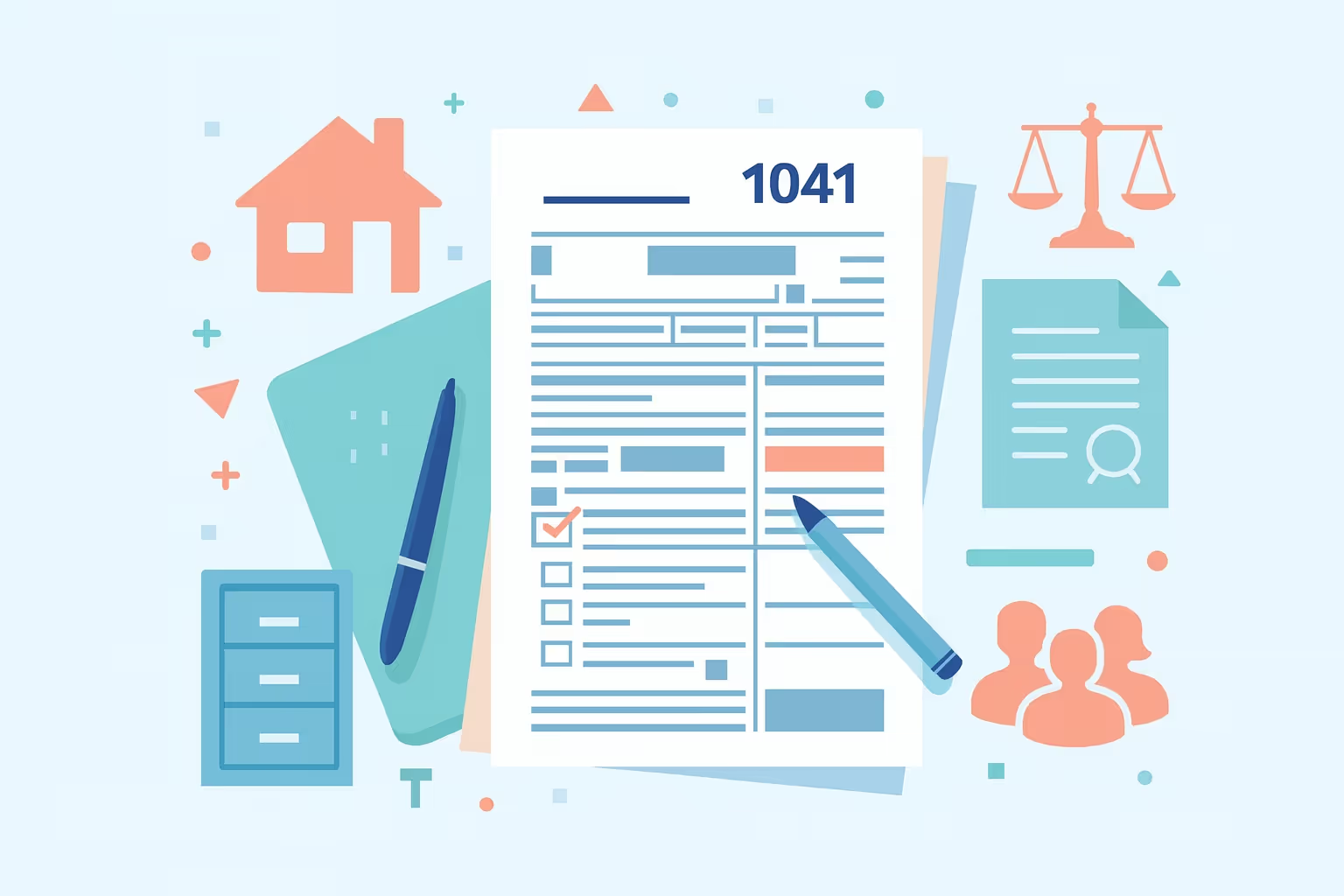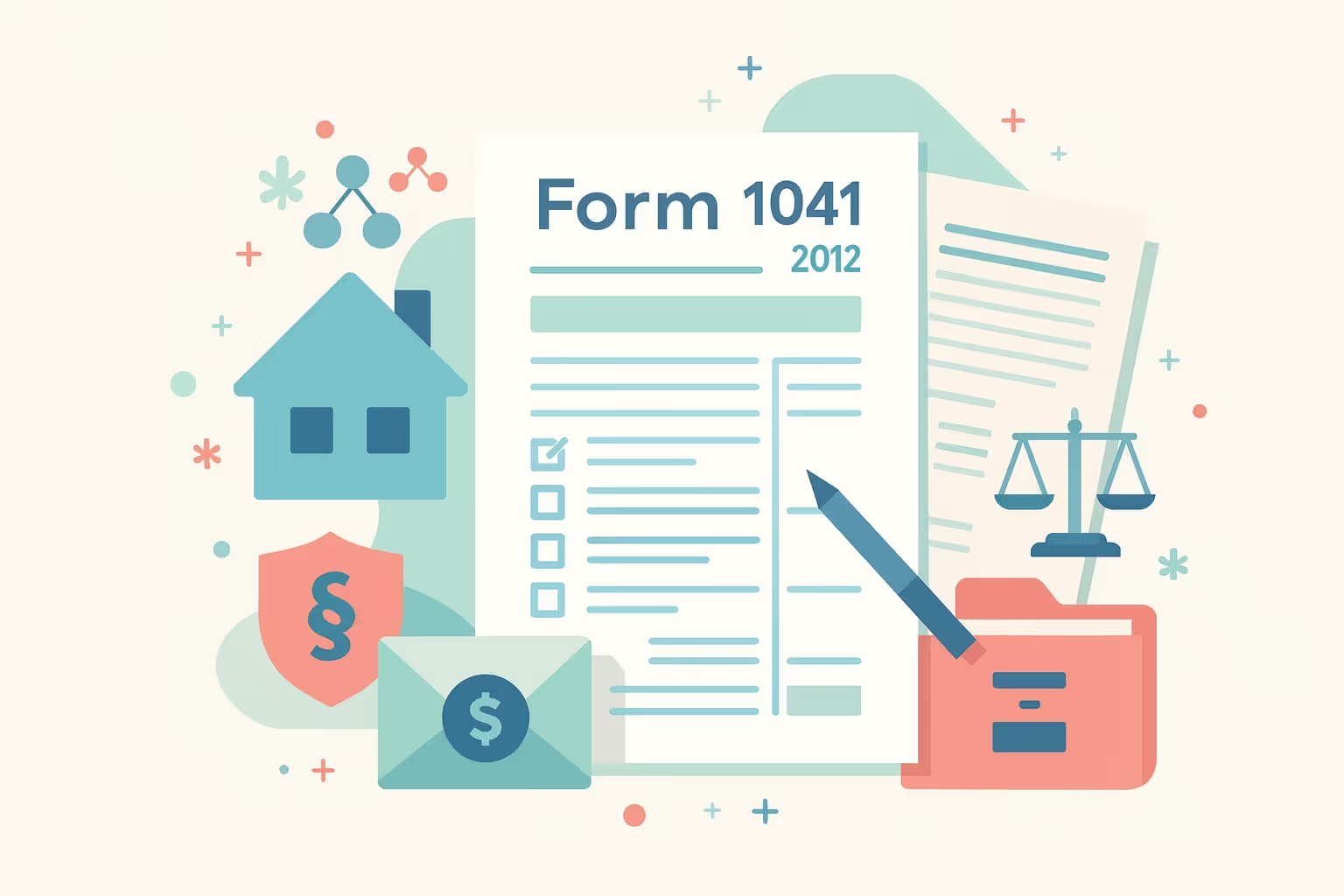How to File Federal Form 1041 for Tax Year 2022
Fiduciaries file over 3 million estate and trust tax returns annually with the Internal Revenue Service. Even a small mistake can delay refunds for months or trigger unexpected penalties. Filing Federal Form 1041 for tax year 2022 may seem intimidating, but getting it right is crucial for protecting estate assets and keeping beneficiaries satisfied.
Federal Form 1041 is the income tax return for estates and trusts. It reports income earned from savings accounts, mutual funds, rented property, and wages paid to household employees. This return also calculates taxable income, deductions, and tax credits, and determines whether the estate or trust owes additional tax or is due a refund. Because the gross income filing threshold is just $600, most domestic decedents’ estates and trusts with income-producing assets must file.
Filing correctly and on time has significant financial and legal implications. Missing the deadline can result in penalties as high as 5% per month for failure to pay and 10% for failure to file. Incorrectly reporting the beneficiary’s share or deductions could lead to disputes and IRS correspondence. This step-by-step guide will walk you through the process from start to finish, using official IRS instructions to ensure accuracy. By filing early and electronically, you can avoid the painfully slow paper process, reduce the risk of errors, and receive refunds faster.
Understanding Federal Form 1041 for Tax Year 2022
Before filling out any forms, it is essential to understand what Federal Form 1041 is and why it matters. The Internal Revenue Service uses this income tax return to calculate the total income earned by estates and trusts, determine the correct deductions, and ensure that taxes are paid on time. Think of it as the estate’s or trust’s version of a personal income tax return.
What Federal Form 1041 Covers
Form 1041, officially called the “U.S. Income Tax Return for Estates and Trusts,” reports multiple income categories, including:
- Interest and Dividend Income: This includes interest earned from savings accounts, certificates of deposit, and ordinary dividends from mutual funds and stocks. Accurate reporting prevents mismatches with Form 1099 documents sent to the IRS.
- Ordinary Business Income: If the estate or trust operates a business, this income must be reported using Schedule C or related schedules.
- Capital Gains and Other Income: Capital gains from the sale of estate assets or securities must be reported on Schedule D. Other income includes rent from rented property, royalties, and revenue for a decedent, such as a final paycheck.
These income categories ensure that all taxable income is accounted for before deductions and credits are applied.
Who Must File Form 1041
An estate or trust is required to file if it meets one of the following criteria:
- Gross Income Threshold: The estate or trust must file if it has gross income of $600 or more during the tax year. This requirement applies even if no tax is ultimately owed.
- Any Taxable Income: A return must be filed for any taxable income, even if the total is less than $600.
- Nonresident Alien Beneficiary: Filing is required if the estate or trust has a nonresident alien beneficiary. This ensures proper reporting of the beneficiary’s share under U.S. tax rules.
- Qualified Opportunity Fund Investment: A return must be filed if the estate or trust holds a qualified investment in a qualified opportunity fund at any point during the year.
Comparion below summarizes filing requirements for estates versus trusts:
- Domestic Decedent’s Estate
- Filing Trigger: Annual gross income of $600+ or any taxable income
- Example: The estate generates $800 from savings account interest
- Trust (Simple or Complex)
- Filing Trigger: Any taxable income or $600+ gross income
- Example: Trust receives $1,200 in mutual fund dividends
- Either Type (Estate or Trust)
- Filing Trigger: The beneficiary is a nonresident alien
- Example: Beneficiary lives abroad
- These low thresholds mean most active estates and trusts must file Form 1041.
What’s New for Tax Year 2022
Understanding the IRS updates for the 2022 tax year is critical to filing accurately and avoiding penalties. Even experienced estate administrators can miss these changes if they rely on prior-year rules.
Key Updates
- Filing Deadline: For calendar year estates and trusts, the deadline to file Form 1041 is April 18, 2023. This extension accounts for the Emancipation Day holiday in Washington, D.C., and applies nationwide. Filing after this date without an extension may result in late filing penalties.
- Capital Gains Tax Brackets: The maximum 20% capital gains rate applies to estates and trusts with taxable income above $13,700. The 0% rate applies to amounts up to $2,800, while the 15% rate applies to amounts between $2,800 and $13,700. These brackets are much narrower than individual taxpayer ones, meaning estates may reach the top rate quickly.
- Qualified Disability Trust Exemption: The exemption amount increased to $4,400, providing additional tax savings for qualified disability trusts.
- Bankruptcy Estate Filing Threshold: The threshold increased to $12,950 in gross income, meaning more bankruptcy estates must file.
- Electronic Filing Requirements: Form 8879-F (IRS e-file Signature Authorization) may now be used for only one Form 1041 per tax year. The IRS Modernized e-File system accepts the current and prior two years’ returns.
- Deduction Changes: The deduction for mortgage insurance premiums expired for tax years beginning after December 31, 2021, and can no longer be claimed.
By reviewing these updates before preparing the return, fiduciaries can avoid miscalculations and missed deductions that could increase income tax liability.
Step-by-Step Filing Process
Now that you understand what Federal Form 1041 covers and the latest updates for tax year 2022, it is time to go through the process step by step. Following this order will help you avoid missing information, underreporting income, or overlooking deductible expenses.
Step 1: Gather Crucial Documents
Before filling out any form, collect every piece of financial data related to the estate or trust:
- Will or Trust Agreement: Read the governing documents carefully because they determine how income and distributions must be reported under the Internal Revenue Code. This step ensures compliance and prevents misallocation of income.
- Form 1099s and K-1s: Collect every Form 1099 for interest, dividends, and capital gains to avoid mismatches with IRS records. Reviewing prior-year K-1s can also provide insight into recurring income sources.
- Bank and Brokerage Statements: Verify the total income generated from savings accounts, mutual funds, and other income-producing assets to reconcile with the annual gross income reported on the return.
- Expense Receipts: Keep detailed records of fiduciary fees, attorney fees, and other deductible expenses to ensure you claim every allowable deduction and reduce taxable income.
Step 2: Obtain an Employer Identification Number (EIN)
Every estate or trust must have its own EIN, and using a decedent’s Social Security number is prohibited.
- How to Apply: For the fastest processing, apply online at IRS.gov or submit Form SS-4 by mail or phone at 1-800-829-4933.
- Special Note: If a revocable living trust becomes irrevocable because the grantor has died, you must obtain a new EIN for tax reporting purposes.
- If Pending: You should enter “Applied For” with the application date to avoid processing delays.
Step 3: Choose the Tax Year
Determining the correct tax year is essential for meeting deadlines:
- Calendar Year Estates: Most estates use a calendar year from January 1 to December 31 for filing.
- Fiscal Year Estates: You may elect a fiscal year that ends on the last day of any month within 12 months of the decedent’s death. For example, if a person passes away on March 15, 2022, you could choose a tax year ending February 28, 2023.
- Trusts: Trusts generally must use a calendar year unless they qualify for special elections under IRS rules.
Step 4: Complete the Entity Information Section
Fill out the top section of Form 1041 completely and accurately:
- Entity Name: Use the exact legal name, such as “Estate of John Smith,” as listed on the EIN application.
- Fiduciary Details: List the estate executor, trustee, or personal representative and the complete mailing address where IRS notices should be sent.
- Entity Type Checkboxes: Select every box that applies, such as decedent’s estate, simple trust, complex trust, or qualified disability trust, to ensure the IRS correctly classifies the filing.
Step 5: Report Income (Lines 1–8)
Carefully report each income category since incomplete reporting is a common reason for IRS notices.
- Interest Income (Line 1): Report all taxable interest from savings accounts, CDs, and bonds exactly as shown on the Form 1099-INT documents.
- Ordinary Dividends (Line 2): Include dividends from stocks, mutual funds, and REITs to prevent mismatches with IRS records.
- Business Income (Line 3): Attach Schedule C if the estate or trust operated a business and report all ordinary business income and related expenses.
- Capital Gains (Line 4): Complete Schedule D to report all gains or losses from the estate's sale of securities or property.
- Rents and Royalties (Line 5): Report rental income and royalty payments on Schedule E and include allowable expenses to calculate net income.
- Farm Income (Line 6): Use Schedule F if the estate operated a farm, and include all farming income and expenses.
- Ordinary Gain or Loss (Line 7): Report the sale of business assets using Form 4797 to determine ordinary gains or losses.
- Other Income (Line 8): Include final paychecks, income in respect of a decedent, and any other miscellaneous taxable income.
Step 6: Calculate Deductions (Lines 10–20)
These deductions can significantly lower taxable income and reduce the estate’s or trust’s overall income tax liability:
- Interest Paid (Line 10): Deduct mortgage or investment interest that meets IRS limitations to reduce taxable income.
- Taxes (Line 11): Include state and local income taxes, real estate taxes, and personal property taxes paid during the tax year.
- Fiduciary Fees (Line 12): Deduct reasonable executor and trustee fees when paid for administration purposes and supported by documentation.
- Charitable Deductions (Line 13): Report bequests or donations to qualified charitable organizations and attach Schedule A if required.
- Professional Fees (Line 14): Deduct attorney, accountant, and return preparer fees directly related to managing or filing the return.
- Other Deductions (Line 15a): Include administrative expenses, investment advisory fees, depreciation, and depletion as allowable deductions.
- Net Operating Loss (Line 15b): Report any net operating loss carryforward from a prior year to offset current income.
- Income Distribution Deduction (Line 18): Deduct amounts distributed to beneficiaries since this shifts taxable income from the trust or estate to the beneficiaries’ personal income tax returns.
Step 7: Compute Tax and Credits (Lines 21–31)
After calculating adjusted total income, compute the tax owed:
- Taxable Income: Subtract deductions, exemptions, and the income distribution deduction from total income to calculate taxable income.
- Apply Tax Table: Use the IRS tax computation worksheet for estates and trusts to determine income tax owed.
2022 Tax Brackets for Estates and Trusts
- Tax Rate: 10% of taxable income
- Tax Rate: $275 plus 24% of the amount over $2,750
- Tax Rate: $1,979 plus 35% of the amount over $9,850
- Tax Rate: $3,239 plus 37% of the amount over $13,450
- Credits (Lines 23–26): Claim any foreign tax credit, general business credit, or credit for prior-year minimum tax if eligible.
- Net Investment Income Tax: Complete Form 8960 if the estate or trust’s income exceeds the applicable thresholds.
Step 8: Determine Balance Due or Refund
- Total Payments (Line 31): Add withholding, estimated payments, and any overpayment applied from the prior year.
- Balance Due: Pay the amount owed by the filing deadline using Form 1041-V and avoid late payment penalties.
- Refund: Choose direct deposit to receive any overpayment more quickly and reduce the risk of lost checks.
Completing these steps carefully ensures that income, deductions, and tax credits are reported accurately and that fiduciaries meet their legal obligations.
Filing and Payment Methods
After completing Form 1041 and verifying that all income, deductions, and tax credits are accurate, the next step is to file the return and make any required tax payments. Choosing the correct filing method and paying on time can prevent penalties and speed up refunds.
Electronic Filing
Electronic filing is strongly recommended because it reduces errors and shortens processing time.
- Faster Processing: E-filed returns are typically processed within two to three weeks, while paper returns can take six to eight weeks or longer.
- Immediate Confirmation: The Internal Revenue Service acknowledges receiving your income tax return.
- Error Reduction: Most tax preparation software checks for missing information, miscalculations, and common mistakes before submission.
- Requirements: You must have an employer identification number (EIN), complete Form 8879-F (IRS e-file Signature Authorization), and keep a copy of the signed authorization for your records.
Paper Filing
Paper filing is still available, although it is generally slower and less convenient.
- When to File by Paper: Paper filing may be appropriate if electronic filing is unavailable for your situation, or if you prefer to file manually for recordkeeping purposes.
- Mailing Addresses: If you owe tax, mail the return and payment to the IRS address in Charlotte, North Carolina. If you expect a refund, send the return to the IRS address in Austin, Texas. Always check the current IRS instructions for the most up-to-date mailing addresses.
- Documentation: Ensure that the return is signed and dated and that all required schedules and attachments are correct.
Payment Options
Paying on time avoids costly penalties and interest charges.
- Electronic Federal Tax Payment System (EFTPS): This free government system allows you to make payments securely online 24/7.
- Direct Debit with E-filed Return: You can authorize an automatic withdrawal from a bank account and schedule it for the due date.
- Credit or Debit Card: Payments can be made using a card, although third-party processors will charge a small percentage fee.
- Check or Money Order: If paying by mail, make checks payable to “United States Treasury” and include the EIN and tax year on the memo line.
Required Schedules and Attachments
Federal Form 1041 is rarely completed on its own. Most estates and trusts must attach additional schedules to report income categories, deductions, and beneficiary information accurately. Failing to include the proper schedules can result in processing delays or IRS correspondence.
Schedule A – Charitable Deduction
Schedule A reports charitable contributions made by the estate or trust.
- You must file this schedule if any portion of the estate’s or trust’s income was distributed to a qualified charitable organization.
- Attach documentation proving that the organization is tax-exempt and that the governing documents properly authorized the contribution.
Schedule B – Income Distribution Deduction
Schedule B calculates the income distribution deduction, which can reduce the estate’s or trust’s taxable income.
- This deduction shifts taxable income to the beneficiaries, who then report it on their personal income tax returns. Correctly calculating this amount ensures that beneficiaries are not over- or under-reported for tax purposes.
Schedule D – Capital Gains and Losses
Schedule D reports gains and losses from selling estate or trust property, including securities and real estate.
- This schedule determines the amount of capital gains that are taxed at the estate or trust level and the amount that can be distributed to beneficiaries.
- Carryover basis rules must be followed for inherited property to calculate capital gains accurately.
Schedule K-1 – Beneficiary’s Share
Schedule K-1 is required whenever income, deductions, or credits are allocated to beneficiaries.
- Each beneficiary must receive a Schedule K-1 by the filing deadline, even if no cash was distributed.
- Filing this schedule ensures that the IRS has information that matches what the beneficiaries report on their personal returns.
Attaching schedules in the proper order is critical. The IRS recommends placing Schedule I first, followed by Schedule D, and then all other required forms and attachments. Be sure to include the estate’s or trust’s employer identification number on every page to avoid misplacement.
Common Errors and How to Avoid Them
Even experienced fiduciaries and trustees make mistakes that can lead to IRS notices, penalties, and delayed refunds. Reviewing these common errors can help avoid problems and protect the estate’s assets.
- Using the Wrong Identification Number: Some filers mistakenly use the decedent’s Social Security number instead of obtaining an employer identification number. This error will cause the IRS to reject the return and delay processing.
- Failing to Report All Income: Underreporting can result from forgetting to include interest from savings accounts, mutual fund dividends, or a final paycheck after death. This oversight often results in IRS notices and additional tax assessments.
- Misclassifying the Entity Type: Not selecting the correct box for simple trust, complex trust, or decedent’s estate can cause the IRS to misclassify the return, potentially triggering incorrect calculations.
- Omitting Required Schedules: Leaving out Schedule D for capital gains or Schedule K-1 for beneficiaries may result in penalties and confusion for beneficiaries who must report their share of income.
- Claiming Disallowed Deductions: Some fiduciaries mistakenly claim beneficiaries' personal expenses or deduct costs unrelated to the estate administration or trust. This can result in disallowed deductions during an IRS review.
- Filing Late Without an Extension: Missing the filing deadline without submitting Form 7004 can result in penalties of up to 5% per month, unnecessarily increasing the estate’s tax liability.
Reviewing the return carefully, keeping organized records, and filing on time will reduce the risk of these errors and help maintain compliance with IRS requirements.
Notable Cases and Zero-Activity Returns
Not every estate or trust has significant income during the tax year, but filing Form 1041 may still be required. Understanding when to file in low-activity years helps fiduciaries remain compliant and avoid unnecessary IRS inquiries.
- Required Filing with Minimal Income: A return must still be filed if the estate or trust has gross income of $600 or more, even if all of it is tax-exempt. A return must also be filed if there is any taxable income, a beneficiary is a nonresident alien, or the estate or trust holds a qualified opportunity fund investment.
- Reporting Zero Activity: If you must file without reportable income, complete all entity information and enter zeros on the income lines. You should still claim the proper exemption amount and attach any schedules that apply, even if they show zero amounts.
- Filing a Final Return: When the estate or trust is terminating, check the “Final Return” box, distribute all remaining assets to beneficiaries, and file the last Schedule K-1 for each beneficiary.
- When Filing is Not Required: If gross income is below the threshold, no beneficiaries are nonresident aliens, and there are no qualified investments, filing may not be necessary. Always keep documentation showing why no return was filed in case of a future IRS inquiry.
FAQs
Do I need to file if the estate earned less than $600?
You generally do not need to file if the estate’s annual gross income is below $600, if there are no nonresident alien beneficiaries, and no qualified opportunity fund investments are held. However, filing may still be beneficial to establish a tax history and claim deductions. Filing can also help avoid confusion in future tax years if income increases.
Can I e-file an amended Form 1041?
No, amended income tax returns for estates and trusts must be filed on paper using Form 1041-X. Be sure to include corrected schedules and updated beneficiary’s share information. Filing an amended return when you discover an error will reduce interest and penalties that may accrue if the original return understates tax liability.
How do I report a final paycheck received after death?
Income received after the decedent’s death is considered income for a decedent (IRD). This must be reported as part of the estate’s income on Form 1041. If distributed, the income passes through to beneficiaries via Schedule K-1, and each person must report the income on their personal income tax return.
What if the estate has foreign assets or a foreign trust?
If the estate owns foreign assets or has a connection to a foreign trust, additional IRS reporting requirements apply. This may include filing Form 3520 or 3520-A and complying with FBAR rules for foreign bank accounts. These requirements are part of the Internal Revenue Code and should be handled carefully, often with professional guidance.
What if I cannot pay the full amount due?
You should still file the return on time, even if you cannot pay in full. Partial payment can be sent electronically, by check, or money order for tax payment purposes. The Internal Revenue Service may approve an installment agreement that allows the remaining balance to be paid over several months, reducing additional penalties.






